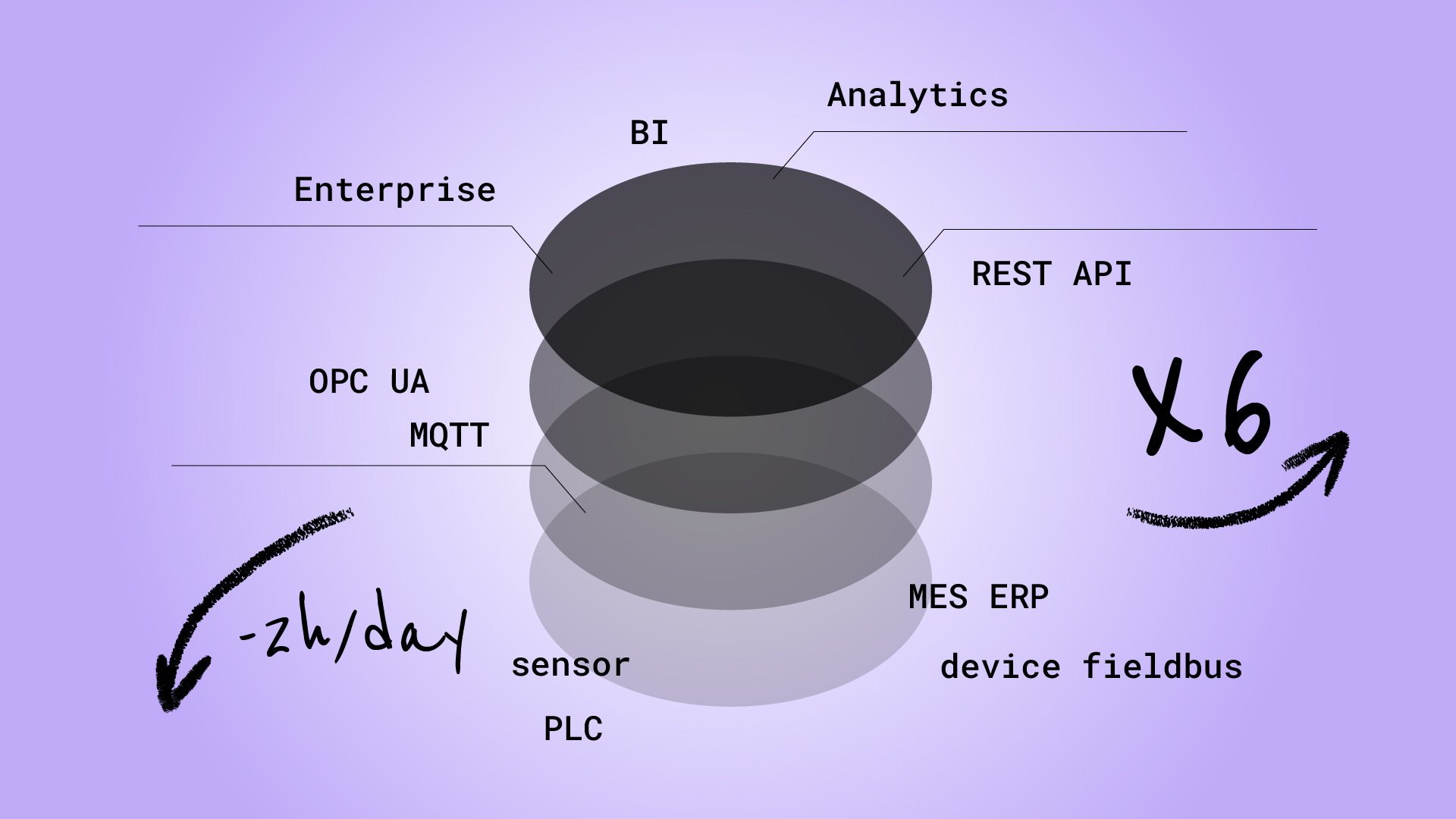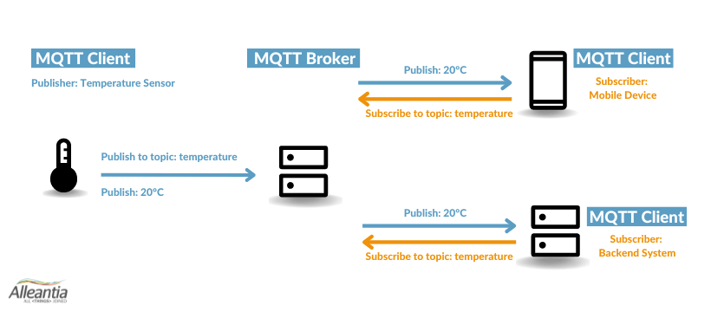
Get to know the advantages of MQTT protocol
The Message Queuing Telemetry Transport (MQTT) protocol is a lightweight and scalable messaging widely used in the Internet of Things (IoT) Let's go to discover what are the advantages of MQTT protocol.
MQTT is developed for communication between resource-constrained devices, such as temperature sensors, actuators, and devices connected to bandwidth-constrained networks
- How to use MQTT service with Alleantia?
- Optimizing machine data acquisition and distribution throughput
- Industrial connectivity in 5 minutes with Alleantia
- Supported Industrial Protocols
What are the main advantages of the MQTT protocol?
One of the features of MQTT is its lightness. The protocol requires minimal bandwidth and computing resources, making it ideal for devices with processing power or connectivity restrictions. MQTT operates over TCP/IP, but unlike other protocols as HTTP, it does not require a persistent connection.
It allows devices to connect quickly, send or receive messages and disconnect immediately, thus reducing the impact on battery life and bandwidth. The importance of connection in the context of the MQTT protocol is crucial for the proper functioning and efficient communication between IoT devices.
The fast and reliable connection enables devices to exchange information in real-time and react to environmental conditions without significant delays.
MQTT adapts perfectly to the resource constraints of IoT devices, allowing them to connect and disconnect as needed, avoiding maintaining a persistent connection that could be costly in terms of energy and network resources. MQTT's fast connection capability allows devices to send and receive messages efficiently, reducing energy consumption and extending battery life.
In addition, MQTT offers QoS (Quality of Service) levels that ensure reliable message delivery even in unstable or intermittent connectivity conditions. It's crucial in an IoT context, where data loss or inappropriate retransmission could cause serious problems, such as monitoring errors or interruptions in automation systems.
The reliable connection offered by MQTT is a crucial element in the IoT context. Through fast connections and immediate disconnections, MQTT reduces the impact on battery life and bandwidth. In addition, QoS levels ensure reliable message delivery, maintaining data integrity and reliability in the IoT ecosystem.
Thanks to these features, MQTT has established itself as one of the most widely used protocols for communication in the IoT environment.
The importance of the MQTT protocol in the IoT context stems from several advantages it offers:
- Efficiency and lightweight: MQTT requires minimal resources to deploy on IoT devices, enabling it to function even on devices with limited processing capabilities. Its messaging structure reduces network bandwidth usage and optimizes communication efficiency.
- Scalability: MQTT supports communication with a large number of IoT devices simultaneously. Developed to handle millions of devices, enabling the creation of extensive and scalable IoT networks.
- Reliability: MQTT provides three levels of quality of service (QoS) that enable reliable delivery of messages even with unstable or low-bandwidth connections, ensuring that messages are delivered as desired and that critical data is not lost.
- Security: MQTT offers built-in capabilities for message encryption and authentication of devices and users. It supports modern authentication and encryption protocols, ensuring secure communications between IoT devices.
- Broad support: The MQTT protocol is widely supported in several programming languages, making its implementation quick and easy. Developers can easily integrate MQTT into their IoT applications using ready-to-use libraries and tools.
Thanks to these advantages, MQTT has become a de facto standard for communication in the IoT, providing a solid basis for efficient, scalable, and secure data exchange between connected devices.
What are the MQTT components?
MQTT implements the publish/subscribe model, in which devices using MQTT can be defined as MQTT clients. An MQTT client can act either as a publisher by sending messages or as a subscriber by receiving them.
The MQTT broker plays the role of a backend system that orchestrates message communication between clients. The broker's responsibilities include receiving, filtering, and forwarding messages to subscribed clients.
Client and broker connection is made through a CONNECT message sent by the client to the broker, followed by the broker's connection confirmation through a CONNACK message. MQTT clients only connect to the broker and not to each other directly.
Role of MQTT protocol in IoT
MQTT communication model is a publish-subscribe paradigm, and the parties involved are the publisher, the broker, and the subscriber.
The publisher is the device that sends the messages, the broker is an intermediary that receives the messages and routes them to interested subscribers, and the subscribers are the devices that receive messages and process them.
Messages
are identified using MQTT topics. Publishers send messages to a specific topic, while subscribers subscribe to one or more topics to receive what they are interested in. The broker manages the subscribers' subscriptions and routes the messages to the correct subscribers. This communication model allows flexibility and scalability in the IoT architecture, as devices can selectively communicate only with topics relevant to them.
Another aspect of MQTT is its QoS (Quality of Service) mechanism. MQTT offers three levels of QoS to ensure the reliable delivery of messages:
- QoS 0 (At most once): The message is sent once without a guarantee of delivery. No retransmission attempt if the message is not received.
- QoS 1 (At least once): The message is sent at least once; the broker confirms receipt and, if necessary, sends a delivery confirmation to the publisher. If the publisher doesn't receive confirmation, it retransmits the message.
- QoS 2 (Exactly once): The message undergoes a single, precise transmission; the broker and subscriber exchange messages to ensure delivery without duplication.
To sum up, MQTT is a messaging protocol that works by following the following steps:
- The MQTT client connects to the MQTT broker. The client can publish messages on specific topics or subscribe to topics of interest. Once published, the broker receives it.
- The broker routes the message to clients previously subscribed to the corresponding topic.
- The subscribed clients receive messages related to the topics subscribed to. Clients can continue the loop by publishing new messages or subscribing to topics.
Through this publish/subscribe model, MQTT allows IoT devices to exchange information efficiently and selectively, ensuring scalable and lightweight communication.

- How to use MQTT service with Alleantia?
- Optimizing machine data acquisition and distribution throughput
- Industrial connectivity in 5 minutes with Alleantia
- Supported Industrial Protocol
MQTT protocol applications
The MQTT protocol, which is widely supported and has a wide range of tools and libraries to simplify its implementation, is crucial in the Internet of Things (IoT) due to its lightweight, scalable, reliable, and secure characteristics.
In the publish/subscribe model, MQTT enables devices to send and receive messages on specific topics, ensuring selective and efficient communication. In this scenario, the MQTT broker plays a key role in coordinating messages between clients, which can act as both publishers and subscribers.
Fast connection and the ability to handle intermittent connectivity are essential features of MQTT, allowing devices to exchange information in real time with little impact on battery life and bandwidth.
In addition, MQTT's Quality of Service (QoS) levels ensure reliable message delivery, even with unstable connections.
The flexibility, broad support, and advanced features of MQTT make it one of the most widely used protocols in the IoT to enable efficient, scalable, and secure communication between connected devices.
An example of an IoT platform that fully exploits the potential of MQTT?
Alleantia's platform offers complete solutions for integrating data from industrial devices and implementing advanced IoT systems. By adopting MQTT, Alleantia ensures interoperability between IoT devices and efficient data transmission, thus contributing to the automation of industrial processes.



